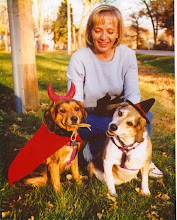Border collies are an energetic, highly intelligent breed, and our new dog, Flirt, is no exception. We are fortunate to have a big yard and conservation land directly behind our house with miles of trails, so Flirt gets plenty of walking time. Wanting to find something else to occupy our little border collie, we decided to look into herding.
Two weekends ago, we loaded Flirt into the car and drove to Magic’s Legacy, a farm on the Wisconsin border, where Shannon Wolfe teaches people and their dogs about herding. Shannon was offering a weekend of herding instinct tests so people could find out if their dogs had any affinity for this canine sport.
Flirt was one of 15 dogs in the Sunday afternoon session, which began with a demo in which two very talented border collies (and their handlers) effortlessly maneuvered a large flock of sheep around a pasture. Responding to one word commands and whistles, the dogs proceeded to gather the flock, move them around obstacles, and even split the flock into two groups. It was amazing to see the connection the handlers had with their dogs.
Then the instinct tests began. One by one, Shannon took the dogs into a pen with three sheep. She would begin by walking the dog on leash around the pen, making him aware of the presence of these strange, fluffy critters. After the dog began to notice the sheep, she would encourage him to follow the sheep. If the dog’s interest was aroused, she would drop the leash and let the dog engage in a controlled chase. As Shannon explains it, you cannot instill the herding instinct into a dog. The dog either has an instinct or does not, and if he does, you can then help develop that natural ability.
The first three dogs to be tested were German shepherds. The responses varied, but all three reacted to the sheep and eventually ended up in the controlled chase. “I bet all the dogs here will show some instinct,” I commented to Steve. “It just seems natural that any dog would want to chase the sheep.” Flirt was the fourth dog, and would be the first one to prove my uneducated theory to be way off base.
Once Flirt was in the pen with Shannon, all she did was scan the crowd, looking for us. When Shannon saw this, she asked me to join her in the pen to help make Flirt feel more comfortable. Flirt thought this was great but still showed no interest in the sheep. Then Shannon called for a “sheep party”, in which I was required to chase the sheep around, whooping and hollering, trying to show Flirt how much fun she was missing by not chasing sheep. I succeeded in getting Flirt excited, but the only thing she wanted to chase was me – no sheep. Shannon finally put an end to my embarrassment and determined that we were the proud owners of a border collie with no herding instincts.
Despite our lack of success, we really enjoyed the afternoon. It was such fun to see how the various dogs reacted to the sheep. And no, Flirt was not the only one to fail the instinct test that day. But that’s OK, we’ve already got her enrolled in an agility class. No sheep involved there.














